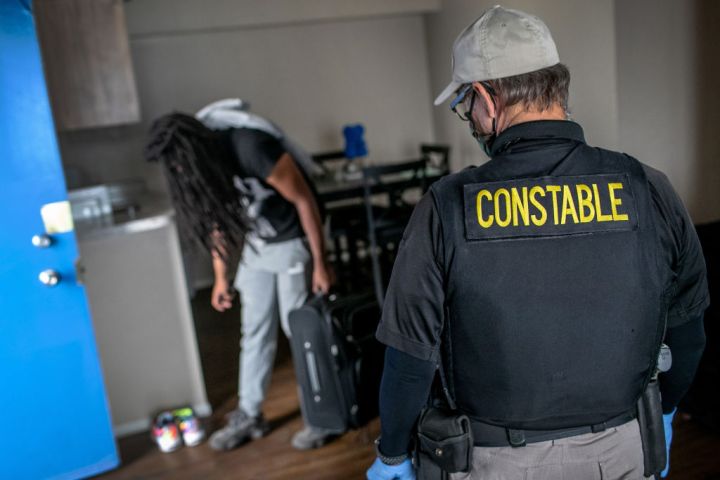
As state eviction bans lapse, another month’s rent comes due
As state eviction bans lapse, another month’s rent comes due

Rent is due on Sunday for millions of people around the country, for the eighth time since the pandemic began, and many don’t know if or how they’ll be able to pay.
In the last six months, around 18% of renters have missed at least one payment, according to the most recent Marketplace-Edison Research Poll, and experts estimate that between 30 and 40 million people are at risk of eviction — or will be once they are no longer protected by an eviction moratorium. That could happen soon.
Already, most states have let their eviction bans expire, and in most places in the country, renters who are behind on rent are now relying on the Centers for Disease Control and Prevention’s nationwide moratorium, which went into effect in September and runs through the end of the year.
“In general, it’s keeping many people housed who would otherwise be losing their homes during the pandemic,” said Diane Yentel, president and CEO of the National Low Income Housing Coalition. “But it’s flawed, and it has a lot of holes that some renters are falling through.”
For one, the CDC moratorium, unlike many state bans, is not automatic — renters have to meet certain criteria, and then sign and submit a declaration form to their landlord to be protected, which not everyone realizes, according to Zach Neumann, founder of the Colorado-based COVID-19 Eviction Defense Project.
He’s had cases, he said, where “tenants would fail to fill out the affidavit provided by the CDC, or maybe they’d fill it out, but they wouldn’t show up for court, or they’d make some other mistake and so they’d be evicted because they weren’t claiming it correctly or successfully.”
Another big hole is that “a number of tenants who are on month-to-month leases, or who are on leases that are expiring, have been getting evicted,” Neumann said. “We were seeing a lot of those cases under the CDC moratorium.
Until last week, when Colorado Gov. Jared Polis decided to reinstate a ban on evictions.
That, according to Neumann, is really significant. “The state moratorium here in Colorado basically closes those holes. So tenants have greater protections as we head into the fall and winter,” he said.
Nationwide, though, just over a dozen states still have some kind of eviction protections in place, in addition to the CDC moratorium. Even in those that do, some evictions have continued.
Since the pandemic began, landlords have filed more than 92,000 evictions in the 24 cities that the Eviction Lab at Princeton University is tracking, including more than 3,500 just in the last week. Since September, when the CDC moratorium went into effect, large, corporate landlords have filed at least 11,500 eviction notices, according to the nonprofit Private Equity Stakeholder Project.
“Part of it has to do with how states and how court systems, how judges really, are interpreting the eviction moratorium,” Yentel said. “And in some places, the judges are interpreting the order as broadly as it was clearly intended to be interpreted, and in other areas, they’re interpreting it much more narrowly.”
Throughout the summer and fall, many states that once had eviction bans in place have let them lapse, including Massachusetts, which for much of the pandemic had some of the strongest protections in the country.
“It’s unfortunate that we can’t continue that same protection forever, said Chris Norris, executive director of the nonprofit Metro Housing Boston. “But the governor did step forward with a variety of different options that we hope to be able to serve as many people as possible as quickly as possible.”
Among those options: about a hundred million additional dollars for the state’s existing emergency rent relief fund. Renters who are struggling, and who meet certain criteria, can apply to the Residential Assistance for Families in Transition program for up to $10,000 in short-term financial assistance.
“It’s a nice first step,” Norris said. “It’s nowhere near enough.”
A recent report from the Metropolitan Area Planning Council found that the gap between what Massachusetts renters owe and what they can afford to pay is around $40 million for the month of October alone.
The fact that the state’s eviction moratorium has expired concerns Norris, he said, “but at some point, I think there’s agreement that an eviction moratorium standing alone, unless there’s some way to guarantee payment to owners, isn’t the solution to the broader problem.”
That solution, most housing advocates agree, needs to come from the federal government and needs to include some form of rent relief.
“The real challenge that we’re facing is on Dec. 31, when this CDC eviction moratorium expires,” Yentel said. “At that point, renters will owe tens of billions of dollars in back rent that they can’t possibly afford to pay. And if there’s not further action from the federal government, we’ll see potentially tens of millions of people losing their homes in the dead of winter and during a surge of coronavirus.”
There’s a lot happening in the world. Through it all, Marketplace is here for you.
You rely on Marketplace to break down the world’s events and tell you how it affects you in a fact-based, approachable way. We rely on your financial support to keep making that possible.
Your donation today powers the independent journalism that you rely on. For just $5/month, you can help sustain Marketplace so we can keep reporting on the things that matter to you.












